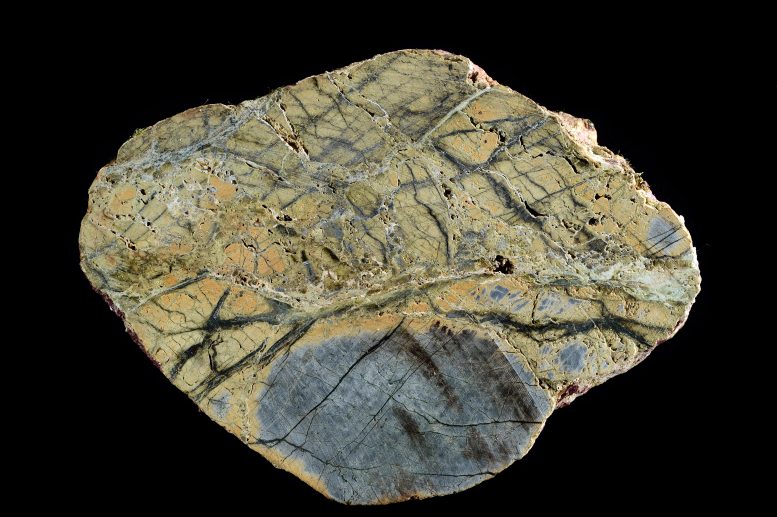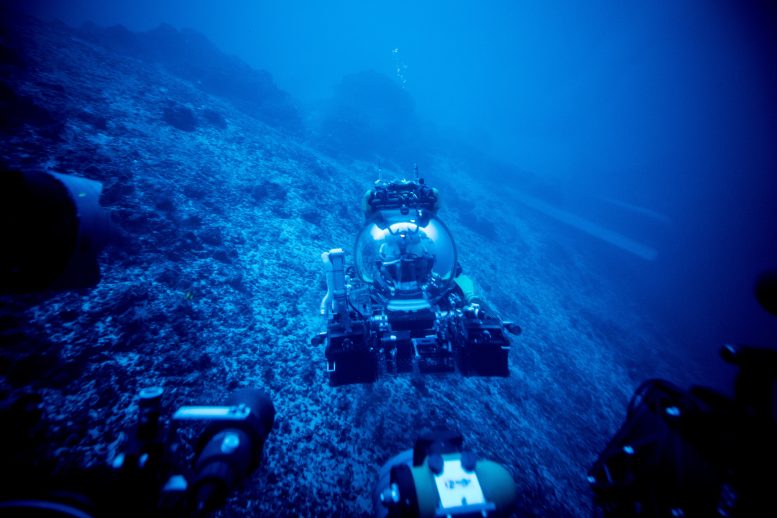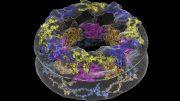
New research has identified oceanic transform faults as significant, previously underestimated sinks for CO2, challenging existing notions about the Earth’s geological carbon cycle. This research emphasizes the crucial role of natural geological emissions in shaping Earth’s climate history and highlights the need for a deeper understanding of these processes in the context of addressing contemporary climate change. Above is a cut slice of altered mantle rock. Credit: Solvin Zankl
Studying a rock is like reading a book. The rock has a story to tell, says Frieder Klein, an associate scientist in the Marine Chemistry & Geochemistry Department at the Woods Hole Oceanographic Institution (WHOI).
The rocks that Klein and his colleagues analyzed from the submerged flanks of the St. Peter and St. Paul Archipelago in the St. Paul’s oceanic transform fault, about 500 km off the coast of Brazil, tell a fascinating and previously unknown story about parts of the geological carbon cycle.
Transform faults, where tectonic plates move past each other, are one of three main plate boundaries on Earth and about 48,000 km in length globally, with the others being the global mid-ocean ridge system (about 65,000 km) and subduction zones (about 55,000 km).
The Role of Transform Faults in Carbon Cycling
Carbon cycling at mid-ocean ridges and subduction zones has been studied for decades. In contrast, scientists have paid relatively scant attention to CO2 in oceanic transform faults. The transform faults were considered “somewhat boring” places for quite some time because of the low magmatic activity there, says Klein. “What we have now pieced together is that the mantle rocks that are exposed along these ocean transform faults represent a potentially vast sink for CO2,” he says.
Partial melting of the mantle releases CO2 that becomes entrained in hydrothermal fluid, reacts with the mantle closer to the seafloor, and is captured there.

Chief Scientist Frieder Klein and Deep Rover Pilot Alan Scot exploring a submerged carbonate platform. Credit: Novus Select
This is a part of the geological carbon cycle that was not known before,” says Klein, lead author of a new journal study published in the Proceedings of the National Academy of Sciences (PNAS). Because transform faults have not been accounted for in previous estimates of global geological CO2 fluxes, the mass transfer of magmatic CO2 to the altered oceanic mantle and seawater may be larger than previously thought.”
Geological Emissions and Climate
”The amount of CO2 emitted at the transform faults is negligible compared to the amount of anthropogenic – or human-driven – CO2,” says Klein. “However, on geological timescales and before humans emitted so much CO2, geological emissions from Earth’s mantle – including from transform faults – were a major driving force of Earth’s climate.”
As the paper states, “global anthropogenic CO2 emissions are estimated to be on the order of 36 gigatons (Gt) per year, dwarfing estimates of average geological emissions (0.26 Gt per year) to the atmosphere and hydrosphere. Yet, over geological timescales, emissions of CO2 sourced from Earth’s mantle have been pivotal in regulating Earth’s climate and habitability, as well as the C [carbon]-concentration in surface reservoirs, including the oceans, atmosphere, and lithosphere.” Klein adds that “this is before anthropogenic combustion of fossil fuels, of course.”
Understanding Climate Change Through Geological Studies
“In order to fully understand modern human-caused climate change, we need to understand natural climate fluctuations in Earth’s deep past, which are tied to perturbations in Earth’s natural carbon cycle. Our work provides insights into long-timescale fluxes of carbon between Earth’s mantle and the ocean/atmosphere system,” says co-author Tim Schroeder, member of the faculty at Bennington College, Vermont. “Large changes in such carbon fluxes over millions of years have caused Earth’s climate to be much warmer or colder than it is today.”
To better understand carbon cycling between Earth’s mantle and the ocean, Klein, Schroeder, and colleagues studied the formation of soapstone “and other magnesite-bearing assemblages during mineral carbonation of mantle peridotite” in the St. Paul’s transform fault, the paper notes. “Fueled by magmatism in or below the root zone of the transform fault and subsequent degassing, the fault constitutes a conduit for CO2-rich hydrothermal fluids, while carbonation of peridotite represents a potentially vast sink for the emitted CO2.”
The researchers argue in the paper that “the combination of low extents of melting, which generates melts enriched in incompatible elements, volatiles, and particularly CO2, and the presence of peridotite at oceanic transform faults creates conditions conducive to extensive mineral carbonation.”
The rocks were collected using human-occupied vehicles during a 2017 cruise to the area.
Finding and analyzing these rocks “was a dream come true. We had predicted the presence of carbonate-altered oceanic mantle rocks 12 years ago, but we couldn’t find them anywhere,” says Klein. “We went to the archipelago to explore for low-temperature hydrothermal activity, and we failed miserably in finding any such activity there. It was unbelievable that we were able to find these rocks in a transform fault, because we found them by chance while looking for something else.”
Reference: “Mineral carbonation of peridotite fueled by magmatic degassing and melt impregnation in an oceanic transform fault” by Frieder Klein, Timothy Schroeder, Cédric M. John, Simon Davis, Susan E. Humphris, Jeffrey S. Seewald, Susanna Sichel, Wolfgang Bach and Daniele Brunelli, 12 February 2024, Proceedings of the National Academy of Sciences.
DOI: 10.1073/pnas.2315662121
Funding for this research was provided by the Dalio Ocean Initiative, the Independent Research & Development Program at WHOI, and the National Science Foundation.









“We had predicted the presence of carbonate-altered oceanic mantle rocks 12 years ago, but we couldn’t find them anywhere,”
That is a little surprising because serpentinites are reasonably common on land, associated particularly with melange terranes and faults, notably the Melones Fault in California, the state in which Woods Hole Oceanographic Institution is located. https://ttu-ir.tdl.org/items/18eb210a-93ca-42b6-ab8d-7da74bca2bf3
See also “mélange” as at https://en.wikipedia.org/wiki/M%C3%A9lange
Woods Hole Oceanographic Institution is located in Massachusetts, not to disparage your comment.
The end of para 4 says “CO.” I assume this should be “CO2.”
Thank you for the note, article has been corrected.
I imagine that sequestration of carbon during the coal and oil forming Era may have had a measurable impact on the global climate of the time. Perhaps the time scale is vast enough to minimize impact, or perhaps wild fluctuations may have come and gone, effecting the organisms responsible for the resulting carbon sequestration of the coal and oil as found today.
The gossamer strength tie-in to climate change assures these researchers of another five year grant from the taxpayers. Reading their journal article will apprise you that this head slapping study has as much to do with the contemporary climate change fantasy as riding a bike. Hell, just read the title.
“Climate change” is a CYCLE, 1000+ years long. Just like we have winters and summers, there are millennia-long warming and cooling cycles. At the peak of the last cycle, Vikings had dairy farms on Greenland. The current hysteria about first a “new ice age” and then “global warming” will soon be overtaken by a new panic about cooling – because we’re just about at the peak of THIS cycle, and the next big change will be cold. The Sun is 100% responsible for climate, and we can see the sunspot cycles – and they’re starting to fade. Let’s hope for another Dalton Minimum rather than another Maunder minimum!
The Greening of Greenland was a regional phenomenon not a global one, brought on by fluctuations in the Gulf stream. Don’t confuse regional with global phenomena to suit your personal point of view.
They don’t understand as much as they think they do.
Thank you for the knowledge and the opinions that you share with the world.
Oh great. Human flatulence is responsible for Greenland melting
People have had climate change wrong from the very beginning ! You can’t predict change without all the facts first! And you still don’t have them….
It seems pretty obvious to me that the Elephant in the room is C02 come mostly from the earths crust along with thermal heat escaping from the very hot core of the planet . These research personnel have to pick their words very carefully on the this subjection as not to contradict the the existing narrative. The fact that our atmosphere is the product op what escapes through the crust 72% of which is ocean floor which contains most of the earths volcanos, none of which seems to have a place in the climate models.
You fallow the main stream histeria you get grants and your papers are published. You fallow Tru you are nobody no grants, no publication, no conferences ….
Very interesting
Ok